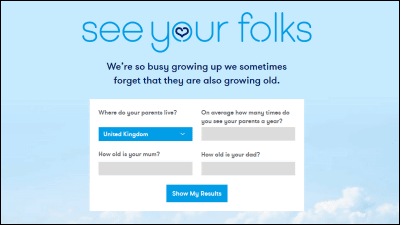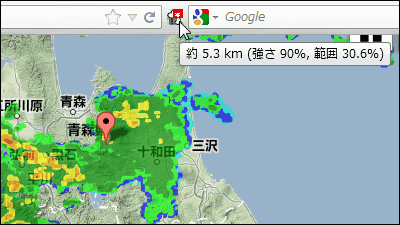'MicroCOVID Project' review that calculates the infection risk of the new corona in detail for each situation such as 'when meeting with friends'

By situation, such as 'How dangerous is it to go shopping at a supermarket?', 'What is the risk of infection when meeting friends?', 'How much can the risk of infection be reduced if you wear a mask at work?' The 'microCOVID Project ' is an online tool that calculates the infection risk of the new coronavirus infection (COVID-19) in detail.
microCOVID Project

It's easy to use, first select the country / region where you want to measure the risk of infection from 'Country or US State:'. This time, I chose 'Tokyo' from 'Japan'.

If you check 'Override location-based data' under the area selection field, you can enter values such as population, number of new cases, and vaccination status. In the case of Japan, the population and the number of newly infected people are entered in advance, but the vaccination status and the rate of increase in cases compared to last week are not entered, so by entering this, simulation by the 'microCOVID Project' It is possible to improve the accuracy of.
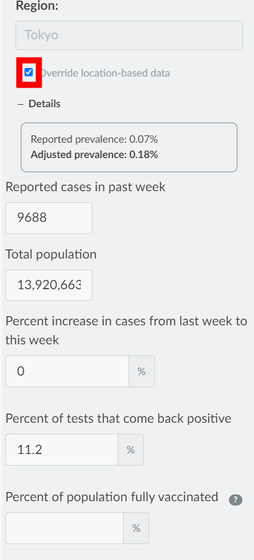
Then select the situation. It is possible to enter in text format, but when you click the text box, the situation will be displayed as shown below, so you can choose from these. This time, I selected 'Grocery store for 60 minutes (crowded)'.
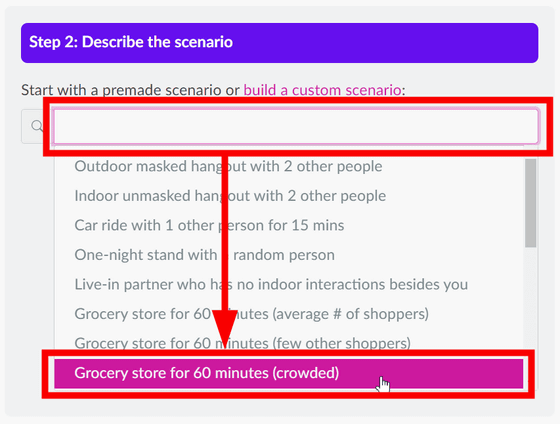
The infection risk at the set '60 minutes shopping at the grocery store: during congestion' was 'Moderate Risk' and was calculated as '40 microCOVIDs'. Since ' 1microCOVID = probability of being infected with COVID-19 is 0.0001% ', the probability of infection seems to be as low as 0.004%, but since the annual permissible amount of an individual is set to '10000microCOVIDs (probability of infection 1%)', The overall rating is 'moderate risk'.

In addition, you can enter your own vaccination status from 'Your Vaccine'. You can choose the type of vaccine you have taken and the number of vaccinations you have taken.
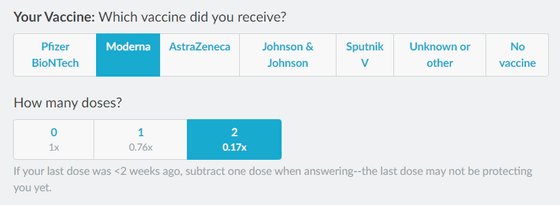
After setting the situation, it is possible to change various numerical values in detail. In 'Near by people', you can set the situation of people around you in detail. 'People' is the number of people within 5 meters, 'Distance' is the average distance of the people around, 'Duration' is the time it takes to shop, 'Risk Profile' is the infection risk scale for each user set by the microCOVID Project, ' 'Their vaccine' is entered whether or not you have been vaccinated, and it is automatically entered when you select a situation, but you can change the values and settings as appropriate.
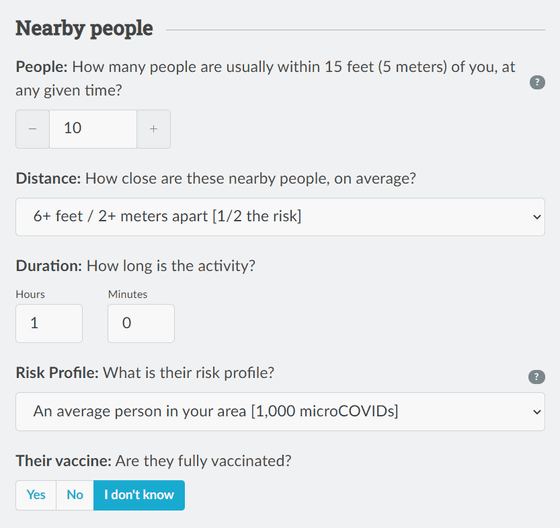
In 'Precautions', you can set the infection control status of the surrounding area. 'Environment' can be selected indoors or outdoors, and the ventilation status of the facility. In 'Your mask', you can select whether or not you are wearing a mask and what kind of mask you are wearing. In 'Their mask', you can select the mask information of people around you other than yourself in the same way as 'Your mask'. In 'Their talking volume', you can select the volume of the voice of the people around you when talking.
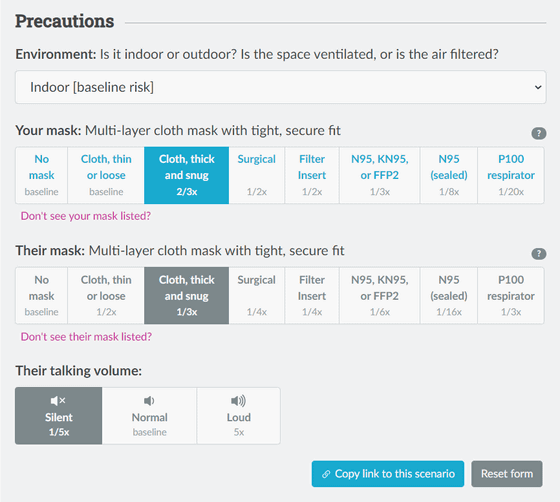
In addition, the risk of infection in Tokyo at the time of writing the article is ' 3 people talk indoors without a mask ' (very high risk: 500 microCOVIDs), ' 15 minutes drive with 2 people ' (medium risk: 60 microCOVIDs) , ' One night with any person ' (Very dangerous risk: 1000microCOVIDs), ' Flight on a full plane ' (High risk: 200microCOVIDs), ' Eating in an indoor restaurant ' (Very dangerous risk: 3000microCOVIDs) ) Etc. were calculated. Since the vaccination status around each situation, how to take social distance, and how to wear a mask are different, it is possible to get out the numerical value more strictly by setting in detail.
In the 'microCOVID Project', the annual allowance is set to 10000 microCOVIDs (infection probability 1%), so a simple calculation based on this, the allowance per week is 'about 190 microCOVIDs'. Based on this, it seems that the high risk of infection for each situation can be felt more realistically.
Related Posts:
in Review, Web Service, Science, Posted by logu_ii





